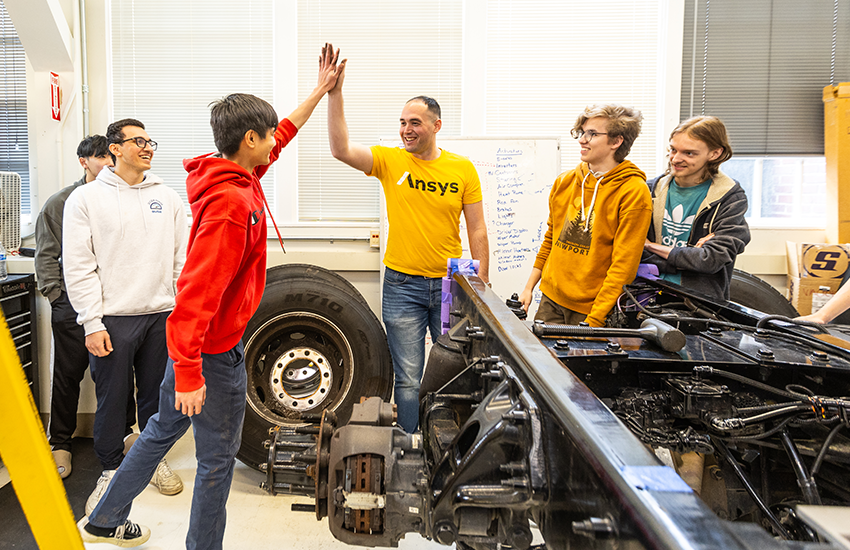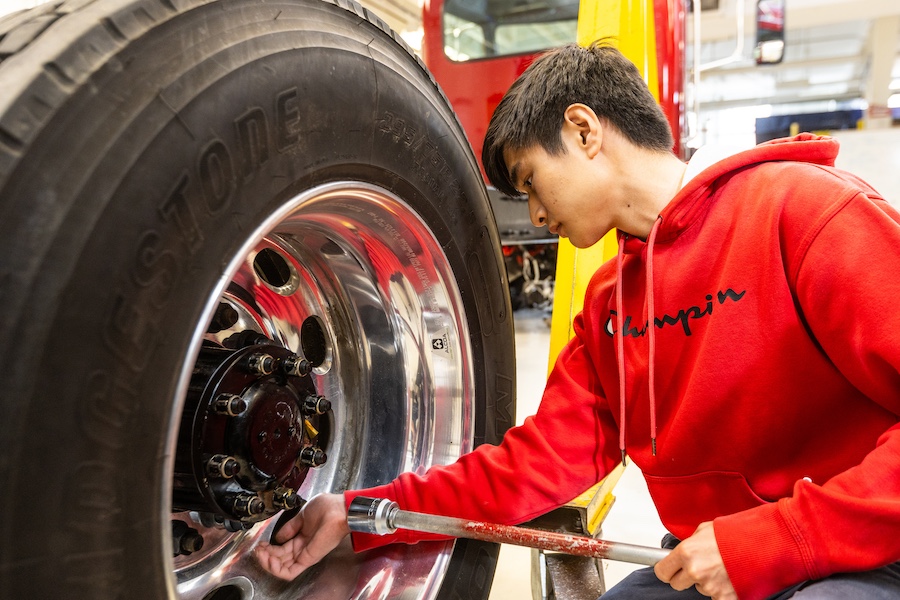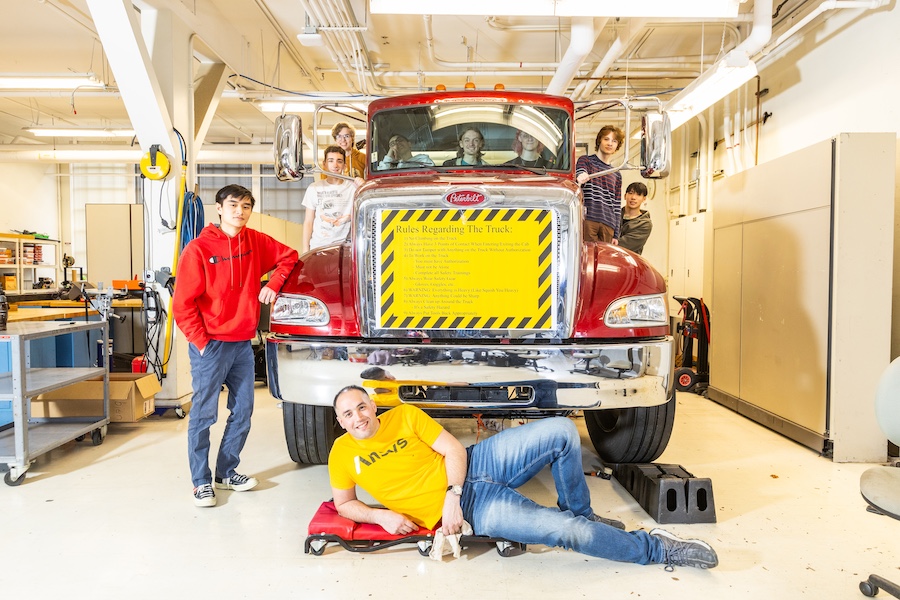By Lyra Fontaine
ME’s newest student club Electric Truck (E-Truck) is daring to do what many other university students haven’t done before: convert a medium-duty diesel truck into a battery electric vehicle.

E-Truck's structures sub-team needed to gain access to and 3D-scan the wheel hubs and suspension. Photo by Raymond Smith/University of Washington
The club has more than 80 students from ME, electrical and computer engineering (ECE), civil and environmental engineering, industrial and systems engineering, computer science and aeronautics and astronautics.
“It’s an amazing team with a positive atmosphere,” says ME senior John Armstrong V, one of the club’s co-founders who serves as the team’s operational director.
The club is building on the momentum of former ME club EcoCAR, which participated in a four-year, multi-university challenge to modify a 2019 Chevrolet Blazer and improve the car’s energy efficiency, safety and consumer appeal. E-Truck students are advised by ME Professor Per Reinhall and sponsored by the PACCAR Technical Center, which has provided the truck as well as mentorship.
“The partnership with the PACCAR Technical Center has been outstanding,” Reinhall says. “E-Truck’s industry mentors, such as systems engineering lead Raeef Barsoum, have been very generous with their time.”
The club has a four-year timeline. By 2027, they plan to have transformed their vehicle into an all-battery electric truck that meets U.S. Department of Energy (DOE) standards. The truck will weigh about 33,000 pounds and run about 200 miles before it needs to be charged, the students estimate.
“We’re working on understanding the truck as a system and figuring out the mileage requirements, the motors and which batteries to use,” Armstrong says.

The team has disassembled the truck to understand its components. Photo by Raymond Smith/University of Washington
According to the DOE, medium- and heavy-duty vehicles generate more than 20% of greenhouse gas emissions from the transportation sector. DOE’s recent study showed that by 2030, nearly half of zero-emissions medium- and heavy-duty electric trucks will be cheaper to buy, operate and maintain compared to diesel-powered combustion engine vehicles.
The club’s members are passionate about sustainable transportation solutions and interested in applying their knowledge to a large-scale project with the potential to make a positive impact on the environment, says Max White, ME senior, E-Truck co-founder and the club’s technical director.
“It’s cool to see the excitement students have for the scope of this project,” White says. “More than half of the students in the club are first-year students, so they might be able to work on this project from start to finish, from idea to final product.”
Outside of being an Engineering Student Organization, E-Truck students are involved in four related capstones in ME and ECE about retrofit packaging optimization, systems engineering, electrical architecture and controls.
“It’s been fun to advise the E-Truck capstone projects and the student organization,” says Reinhall. “While the club is student-led, I answer technical questions and connect them to other faculty with expertise they need. My goal is to keep morale high and make sure the project is fun.”
In addition to Reinhall and industry mentors from PACCAR, ME machine shop lab engineers Eamon McQuaide and Veasna Thon (M.S. ’22) assist the team.
“The students are learning the industry standard way of developing vehicles. They’re also learning about systems engineering, such as specifying what they want to build, designing the truck for a specific goal and ensuring different teams communicate.”
Learning beyond the classroom

E-Truck's structures sub-team with the truck, provided by PACCAR Technical Center. Photo by Raymond Smith/University of Washington
The team prepared for the truck’s arrival by cleaning and organizing the garage room in the Engineering Annex, waxing the floors and inventorying tools and supplies. Members also acquired software for structural analysis, computer-aided design (CAD), 3D modeling, simulations and more.
“We want to train our team with skills that will enable them to be engineering leaders,” Armstrong says.
The truck is now disassembled as the team works to understand its components, such as the wiring, through creating diagrams and building CAD models. Then the team will begin the design process. Next year the work will be more hands-on, with the team testing the truck’s parts, including its engine.
Students are gaining experience with software, equipment such as battery packs and motors and the full-cycle design process. They’re also learning valuable project management, leadership and communication skills. The club emphasizes the importance of knowledge-sharing and collaboration through weekly meetings where sub-teams present their findings.
“Working together to solve technical issues makes the skills students learn about in class come alive, which is helpful for their academic development,” Reinhall says. “The students are learning the industry standard way of developing vehicles. They’re also learning about systems engineering, such as specifying what they want to build, designing the truck for a specific goal and ensuring different teams communicate.”
We’re learning a thorough way of approaching a large process that includes stakeholder analysis. It’s inspiring to learn from PACCAR engineers who visited us. ”
E-Truck’s sub-teams include systems, electrical, controls, drivetrain, structures, public relations, human resources, information technology, administrative, sponsorships and safety.
Chloe’ Marie Miller, a fourth-year electrical engineering student and E-Truck’s public relations lead, joined the club to build on her experiences as a former EcoCAR member. Miller is also hoping to apply the skills she learns to a personal project: getting her pickup truck to start working.
“It’s my first exposure to industry, which is exciting,” Miller says. “We’re learning a thorough way of approaching a large process that includes stakeholder analysis. It’s inspiring to learn from PACCAR engineers who visited us. They have this wealth of knowledge that they’re willing to share and they want to see us succeed.”
It’s a win-win: through E-Truck, students receive industry-standard training, while PACCAR is able to collaborate with students.
“Many companies are looking for different perspectives and out-of-the-box solutions that students can provide,” Reinhall says.
Originally published April 29, 2024